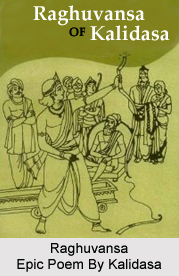 Raghuvansha is a literary epic verse section written by the esteemed poet Kalidasa. The poem is often considered synonymous with the creator and is named sometimes as Raghuvansha Kalidasa. The poem basically delineates the roots of the great lineage of Lord Rama and his descendants and the great captor Raghu. Raghuvansha primarily talks about the gallantry and potency of the great warrior Raghu.
Raghuvansha is a literary epic verse section written by the esteemed poet Kalidasa. The poem is often considered synonymous with the creator and is named sometimes as Raghuvansha Kalidasa. The poem basically delineates the roots of the great lineage of Lord Rama and his descendants and the great captor Raghu. Raghuvansha primarily talks about the gallantry and potency of the great warrior Raghu.
The mighty warrior Raghu heads a military expedition to Transoxiana. He vanquishes and quashes local population along the way (most likely on his march through Central Asia) until he reaches the Vankshu, as the ancient Indians addressed the Oxus River. There, Raghu`s army combats with the Hepthalites, or White Huns, whom the Indians called Hunas and Mlecchas (barbarians). The Hepthalites are overthrown and the Raghuvanshaprides themselves about "The exploits of Raghu, whose valour expressed itself amongst the husbands of the Huna women, became manifest in the scarlet colour of their cheeks." The faces of the overthrown were mutilated beyond human recognition and it is believed that this form of facial mutilation was much in vogue in Central Asia during that time.
After crossing the Oxus, Raghu and his militia came across the Kambojas, an ancient population. The Kambojas yielded themselves to Raghu and offered him gifts and prizes. In the interim, the Kambojas resided in the environs of the Pamirs. Kalidasa distinguishes the predominance of walnut trees in the Oxus country and curiously enough, this specific region is still known for the cultivation of walnuts.
Intriguingly though, the unambiguous reference to the Hepthalites appear to impart weight that Kalidasa lived and led a high-flying life within 4th and 5th centuries A.D. during the rule of Chandragupta Vikramaditya and Kumaragupta, rather than in 1st century B.C. The Hepthalites were relentless enemies of the Imperial Guptas during this era and were inviolable enough to commence ruthless invasions. The savage-like Hepthalites must have deserved substantial importance to materialise in Kalidasa`s work, making it all the more probable that he dwelled in the era they were most vigorous, placing him in 4th-5th centuries.
It is not impossible that the warrior figure Raghu was based on the historical figure of Chandragupta Vikramaditya, who himself achieved triumph and sophistication for the Gupta Empire and also quashed foreign tribes like Sakas. For all its artistic and literary value, Kalidasa`s epic poem Raghuvanshawould also have answered as a fitting exaltation of the esteemed poet`s Gupta patrons.



















